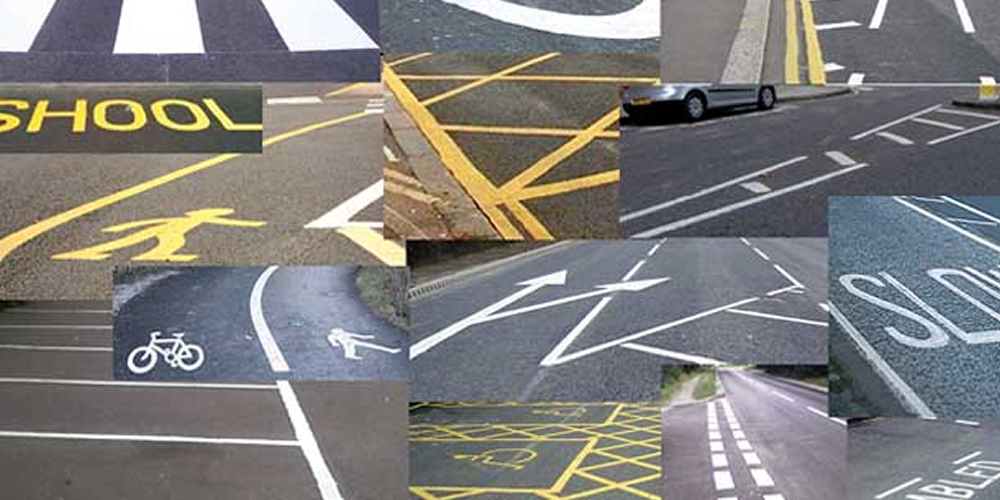
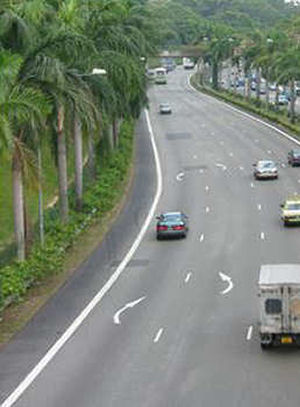 It might seem strange to be considering road markings at this point in your training; after all, you have probably been dealing with Give-Way lanes, Stop lines, central white lines, and other markings since your first driving lesson.
It might seem strange to be considering road markings at this point in your training; after all, you have probably been dealing with Give-Way lanes, Stop lines, central white lines, and other markings since your first driving lesson.
We've designed this lesson to consolidate all of your knowledge and ensure that you fully understand the vital role that road markings play and that you can react correctly to road markings (and any associated signs) without help from your instructor.
Road markings are usually white or yellow, or red. White lines separate traffic streams; yellow or red lines and markings prohibit waiting and parking.
The general rule is: 'more paint... more need for caution'.
The road in the photo is in China; luckily, we don't have markings in the UK like those shown. Which lane do you think they want you to drive in?
During your test, the examiner will expect you to see all road marking and road signs and take action to deal with them.
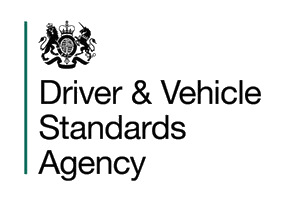
Things the examiner will consider:
Observation of signs and markings
Correct action on all signs and markings
Lane discipline
Following the rules for yellow boxes
Avoiding hatched areas where appropriate
Avoiding yellow lines when parking
Responding to 'slow' or' school' markings
White lines between lanes separate traffic streams; this could be traffic travelling in the same direction in one-way systems or on fast roads - or traffic travelling in opposite directions.
The 'more paint, more caution' rule applies to lines that separate traffic streams - the longer the lines are, the more potential danger there is.

Centre lines of equal length with long gaps between them mark the centre of the road. You can overtake on roads with these lines if it is safe to do so.
We tend to think of these as 'low hazard' lines.
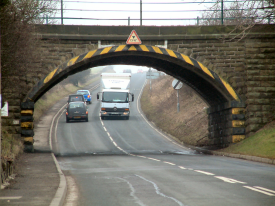
Long white lines with short gaps warn of a hazard. On this road, the risk is pretty obvious. The low bridge means that large vehicles might approach in the centre of the road. Hazards are not always as obvious as this!
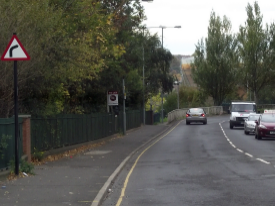
Technically the hazard lines in this picture would allow you to overtake legally. However, the bend would make it dangerous, even if the road was clear. This is why reading road markings as part of the 'bigger picture' is essential.
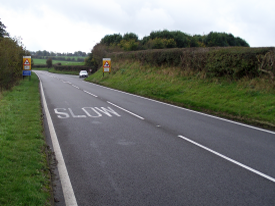
Here we can see hazard lines coupled with a 'SLOW' marking on an open road on the approach to dangerous bends - there is also a lay-by on the right-hand side.
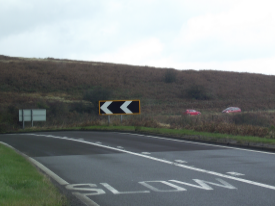
When the line nearest you in a double white line system is solid, you MUST NOT cross or straddle the lines except to enter an opening on the right. You may cross the line if necessary to pass a stationary vehicle or other obstruction, or overtake a pedal cycle, horse slow vehicle if their speed is 10mph or slower.
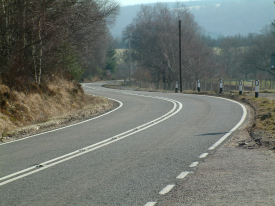
Where there are solid white lines on both sides of the road, no one is allowed to overtake or cross the lines except to enter or leave property or to pass obstructions or vehicles with a speed of 10mph or slower.
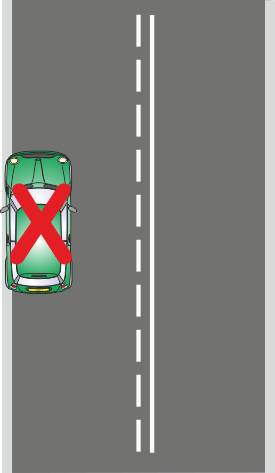
Where the line nearest to you in a double white line system is broken, you may cross it to overtake if it is safe, provided you can complete the manoeuvre before reaching a solid white line on your side. Double white lines also mean no parking, even if there is a broken line on your side.
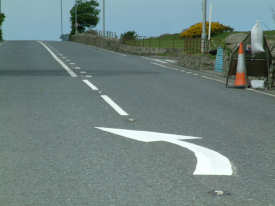
This arrow indicates that you must move to or stay on the left-hand side because there is a solid line ahead. Never start an overtaking manoeuvre where you see these arrows.
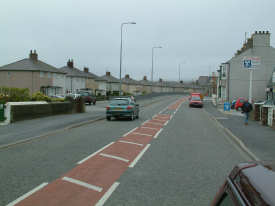
Here the centre markings are 'hatched'. This type of hatching, especially when coupled with a different coloured surface, is to separate traffic streams and increase safety margins. As a general rule, you should avoid driving on the hatched areas edged with broken white lines.
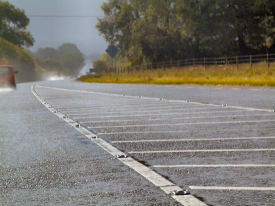
When a solid line bounds the hatched area of the road, you must not enter the hatched area except in an emergency.
Here are some examples of speed control markings that you must be familiar with.
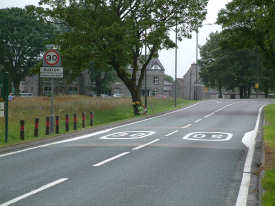
The speed limit signs here are painted onto the road to reinforce the compulsory signs and hazard lines.
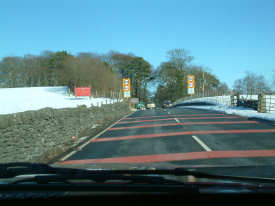
These red bars (sometimes yellow) warn you to slow down, often on the approach to roundabouts. Ridges on the bars will cause your vehicle to vibrate as you drive on them.
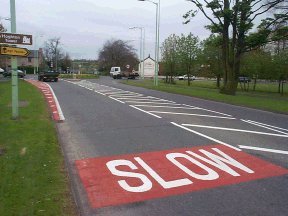
Slow means what it says! Here the slow sign is emphasised by the red tarmac - notice the hatched markings as well. There is a problem ahead – in this case, a dangerous junction.
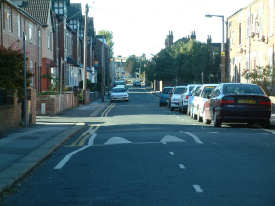
These white triangles are a warning of speed humps - slow down, even if the hump isn't obvious from a distance.

These 'teeth' give an illusion of reduced road width and are designed to slow traffic down.
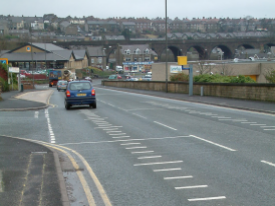
While not a warning, these markings are calibration for speed camera photos. If you are exceeding the speed limit when you drive over these markings... It's too late!
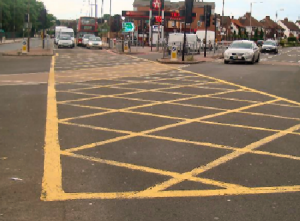
Box junctions, marked with yellow cross-hatching, were introduced in 1964, the first in London. The aim was to prevent vehicles from blocking junctions when they could not proceed; this prevents 'gridlock'.
Authorities use box markings anywhere the road needs to be kept clear. The example on the right shows a yellow box used to keep a junction clear.
Typically you will find yellow box markings in towns or busy intersections. You will also find these markings outside police, fire and ambulance stations or hospitals where vehicles need fast access to the main road.
The basic principle that applies to yellow boxes is that you must only enter the box if there is enough room to exit. It is an offence to block a box junction – with one exception, which we explain below.
The first diagram shows a car at point 'A' wishing to turn right into road 'C'.
As long as road 'C' is clear, it's OK for the car to move to point 'B'. In other words, a driver may enter the box and wait when turning right if the only thing preventing them from turning is oncoming traffic or other vehicles waiting to turn right.
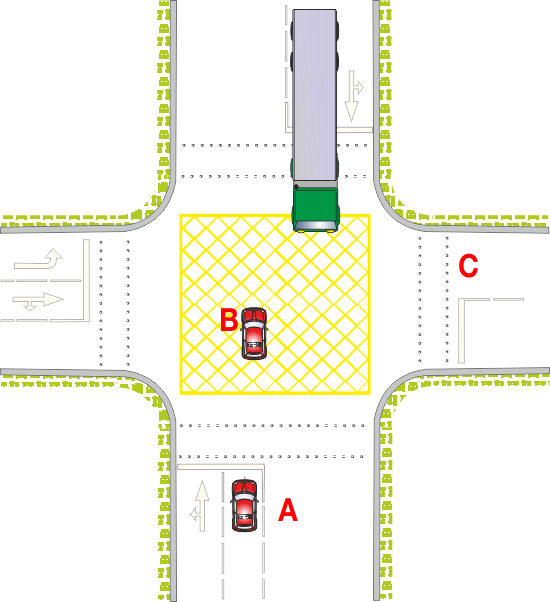
In the situation shown in this second diagram, no one would be able to enter the yellow box because the exits are not clear.
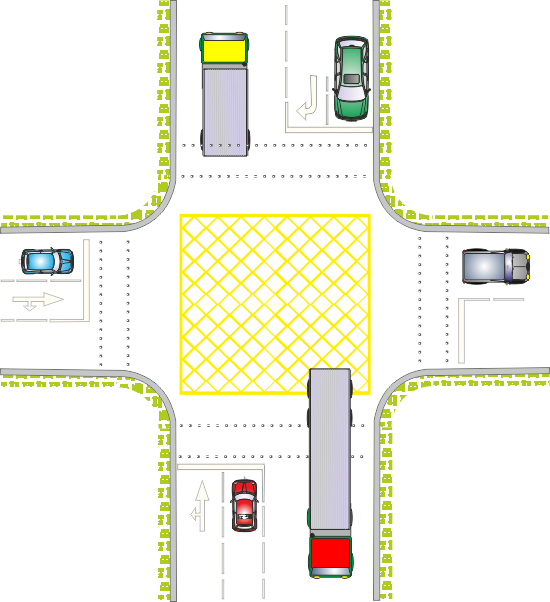
Not knowing these markings could cost you heavy parking fines or vehicle recovery fees.
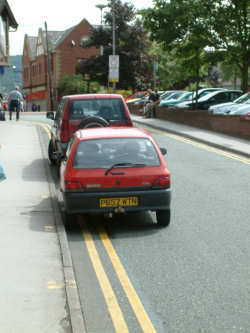
Always check the parking restriction plates for details of when you can park, whether double or single lines. Double yellow lines usually mean no parking at any time.
These drivers can expect to find a parking ticket when they return.
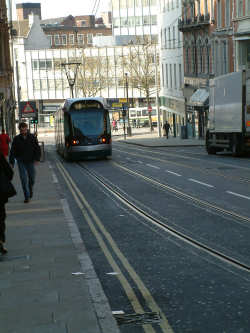
More double yellow lines, park here and the tram won't be able to get around you.
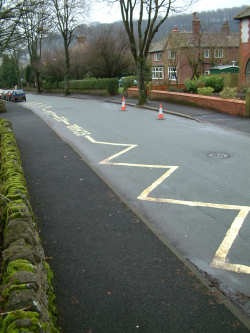
Yellow zig-zag lines are used at school entrances. You must keep these areas clear to make sure the safety of children.
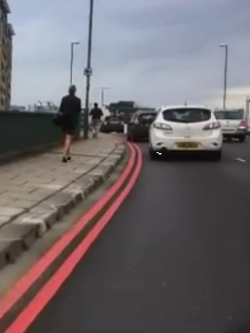
Red route markings keep traffic flowing on major routes. Parking here will result in your vehicle being towed away - it will cost a fine and a recovery fee to get it back.
A sample of some other markings.
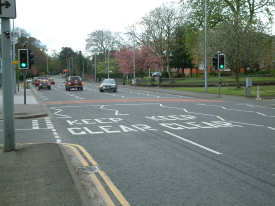
It should be pretty obvious what these markings mean. Like yellow boxes (next page)they are designed to keep entrances and junctions clear. This picture shows the markings keeping a side road
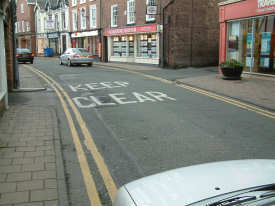
Keep clear markings again, this time used to keep entrances to premises clear.
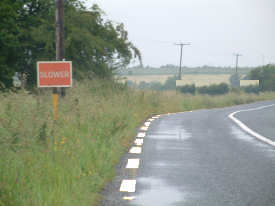
Edge markings show the side of the road. These can be useful at night on open roads.
Where the edge marking is solid, it tells you there’s a hazard, such as a bend, narrow section of road, etc.
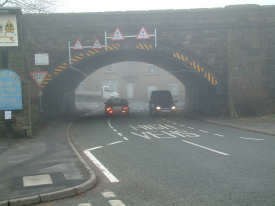
These marking help drivers of high vehicles negotiate low bridges safely. They do not affect car drivers other than to act as a warning that large vehicles may be in the middle of the road.
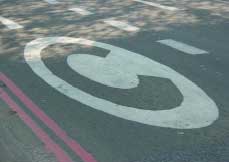
This is an information sign shows that you are entering an area where extra charges are levied for using the road (this one is in Central London). Also notice the Red Route lines.
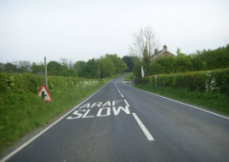
If you drive through Wales, sooner or later you will come across dual-language signs and markings.
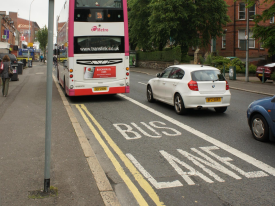
Bus lanes are usually reserved for buses, taxis and cyclists. Look for signs that tell you when a bus lane is operating and when you can drive in it.
When a bus lane is operating you cannot use it for any reason. For example, you could be prosecuted if you set down passengers, park, or move into the bus labe to give way to emergency vehicles.
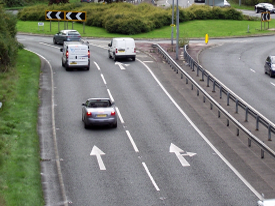
This picture shows arrows on the road surface advising drivers about which lane to take. If you take the wrong lane by mistake and cannot move back, carry on in the direction of the arrows, find somewhere to turn around and then return to the junction to continue your journey.
The workmen on these roads probably had a bit of explaining to do!
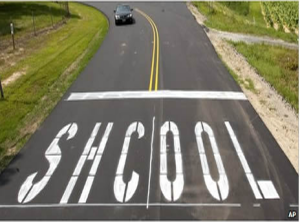
School?
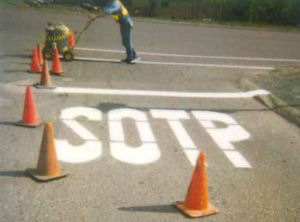
Stop?
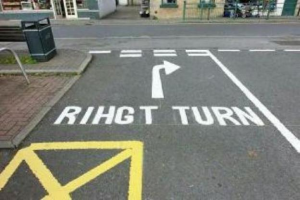
Right Turn?
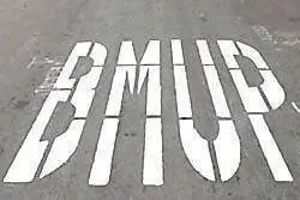
Speed Bump
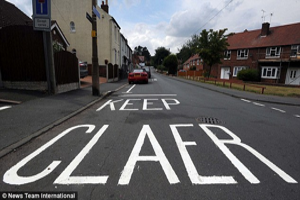
Keep clear
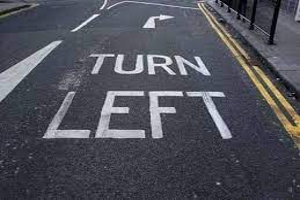
Left? Look at the arrow!
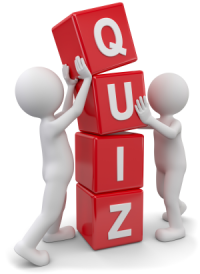 Road Markings Quiz...
Road Markings Quiz...Click here to complete the quiz for this lesson
(The page will open in a new window/tab)
You will find references for the answers in this lesson.
You can check your answers as you go along, or complete the full quiz before checking.
Leaving the check to the end is a good way to test yourself.
When you check or review your answers you will get a brief explanation of the answer.
Good Luck!